3.3. Harmonic Series I: Timbre and Octaves*
Have you ever wondered how a trumpet plays so many different notes with only three valves, or how a bugle plays different notes with no valves at all? Have you ever wondered why an oboe and a flute sound so different, even when they're playing the same note? What is a string player doing when she plays "harmonics"? Why do some notes sound good together while other notes seem to clash with each other? The answers to all of these questions have to do with the harmonic series.
Most musical notes are sounds that have a particular pitch. The pitch depends on the main frequency of the sound; the higher the frequency, and shorter the wavelength, of the sound waves, the higher the pitch is. But musical sounds don't have just one frequency. Sounds that have only one frequency are not very interesting or pretty. They have no more musical color than the beeping of a watch alarm. On the other hand, sounds that have too many frequencies, like the sound of glass breaking or of ocean waves crashing on a beach, may be interesting and even pleasant. But they don't have a particular pitch, so they usually aren't considered musical notes.
Figure 3.13. Frequency and Pitch
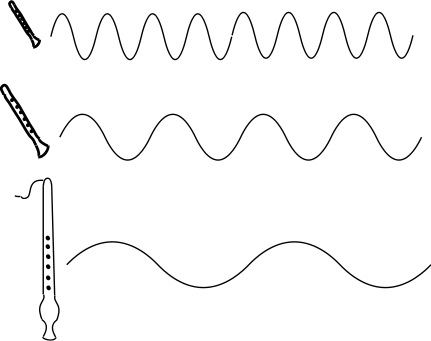
When someone plays or sings a musical tone, only a very particular set of frequencies is heard. Each note that comes out of the instrument is actually a smooth mixture of many different pitches. These different pitches are called harmonics, and they are blended together so well that you do not hear them as separate notes at all. Instead, the harmonics give the note its color.
What is the color of a sound? Say an oboe plays a middle C. Then a flute plays the same note at the same dynamic level as the oboe. It is still easy to tell the two notes apart, because an oboe sounds different from a flute. This difference in the sounds is the color, or timbre (pronounced "TAM-ber") of the notes. Like a color you see, the color of a sound can be bright and bold or deep and rich. It can be heavy, light, dark, thin, smooth, murky, or clear. Some other words that musicians use to describe the timbre of a sound are: reedy, brassy, piercing, mellow, hollow, focussed, transparent, breathy (pronounced BRETH-ee) or full.
The words musicians use to describe timbre are somewhat subjective, but most musicians would agree with the statement that, compared with each other, the first sound is mellow, the second bright, and the third rich.
Exercise 3.3.1. (Go to Solution)
Listen to recordings of different instruments playing alone or playing very prominently above a group. Some suggestions: an unaccompanied violin or cello sonata, a flute, oboe, trumpet, or horn concerto, Asaian or native American flute music, classical guitar, bagpipes, steel pan drums, panpipes, or organ. For each instrument, what "color" words would you use to describe the timbre of each instrument? Use as many words as you can that seem appropriate, and try to think of some that aren't listed above. Do any of the instruments actually make you think of specific shades of color, like fire-engine red or sky blue?
Where do the harmonics, and the timbre, come from? When a string vibrates, the main pitch you hear is from the vibration of the whole string back and forth. That is the fundamental, or first harmonic. But the string also vibrates in halves, in thirds, fourths, and so on. (Please see Standing Waves and Musical Instruments for more on the physics of how harmonics are produced.) Each of these fractions also produces a harmonic. The string vibrating in halves produces the second harmonic; vibrating in thirds produces the third harmonic, and so on.
This method of naming and numbering harmonics is the most straightforward and least confusing, but there are other ways of naming and numbering harmonics, and this can cause confusion. Some musicians do not consider the fundamental to be a harmonic; it is just the fundamental. In that case, the string halves will give the first harmonic, the string thirds will give the second harmonic and so on. When the fundamental is included in calculations, it is called the first partial, and the rest of the harmonics are the second, third, fourth partials and so on. Also, some musicians use the term overtones as a synonym for harmonics. For others, however, an overtone is any frequency (not necessarily a harmonic) that can be heard resonating with the fundamental. The sound of a gong or cymbals will include overtones that aren't harmonics; that's why the gong's sound doesn't seem to have as definite a pitch as the vibrating string does. If you are uncertain what someone means when they refer to "the second harmonic" or "overtones", ask for clarification.
Figure 3.14. Vibrating String

A column of air vibrating inside a tube is different from a vibrating string, but the column of air can also vibrate in halves, thirds, fourths, and so on, of the fundamental, so the harmonic series will be the same. So why do different instruments have different timbres? The difference is the relative loudness of all the different harmonics compared to each other. When a clarinet plays a note, perhaps the odd-numbered harmonics are strongest; when a French horn plays the same note, perhaps the fifth and tenth harmonics are the strongest. This is what you hear that allows you to recognize that it is a clarinet or horn that is playing. The relative strength of the harmonics changes from note to note on the same instrument, too; this is the difference you hear between the sound of a clarinet playing low notes and the same clarinet playing high notes.
You will find some more extensive information on instruments and harmonics in Standing Waves and Musical Instruments and Standing Waves and Wind Instruments.
A harmonic series can have any note as its fundamental, so there are many different harmonic series. But the relationship between the frequencies of a harmonic series is always the same. The second harmonic always has exactly half the wavelength (and twice the frequency) of the fundamental; the third harmonic always has exactly a third of the wavelength (and so three times the frequency) of the fundamental, and so on. For more discussion of wavelengths and frequencies, see Acoustics for Music Theory.
Figure 3.15. Harmonic Series Wavelengths and Frequencies
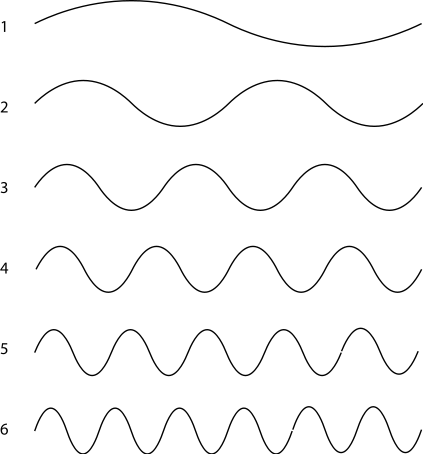
Say someone plays a note, a middle C. Now someone else plays the note that is twice the frequency of the middle C. Since this second note was already a harmonic of the first note, the sound waves of the two notes reinforce each other and sound good together. If the second person played instead the note that was just a litle bit more than twice the frequency of the first note, the harmonic series of the two notes would not fit together at all, and the two notes would not sound as good together. There are many combinations of notes that share some harmonics and make a pleasant sound together. They are considered consonant. Other combinations share fewer or no harmonics and are considered dissonant or, when they really clash, simply "out of tune" with each other. The scales and harmonies of most of the world's musics are based on these physical facts.
In real music, consonance and dissonance also depend on the standard practices of a musical tradition, especially its harmony and tuning practices, but these are also often related to the harmonic series.
For example, a note that is twice the frequency of another note is one octave higher than the first note. So in the figure above, the second harmonic is one octave higher than the first; the fourth harmonic is one octave higher than the second; and the sixth harmonic is one octave higher than the third.
Exercise 3.3.2. (Go to Solution)
-
Which harmonic will be one octave higher than the fourth harmonic?
-
Predict the next four sets of octaves in a harmonic series.
-
What is the pattern that predicts which notes of a harmonic series will be one octave apart?
-
Notes one octave apart are given the same name. So if the first harmonic is a "A", the second and fourth will also be A's. Name three other harmonics that will also be A's.
A mathematical way to say this is "if two notes are an octave apart, the ratio of their frequencies is two to one (2:1)". Although the notes themselves can be any frequency, the 2:1 ratio is the same for all octaves. Other frequency ratios between two notes also lead to particular pitch relationships between the notes, so we will return to the harmonic series later, after learning to name those pitch relationships, or intervals.
Solutions to Exercises
Solution to Exercise 3.3.1. (Return to Exercise)
Although trained musicians will generally agree that a particular sound is reedy, thin, or full, there are no hard-and-fast, right-or-wrong answers to this exercise.
Solution to Exercise 3.3.2. (Return to Exercise)
-
The eighth harmonic
-
The fifth and tenth harmonics; the sixth and twelfth harmonics; the seventh and fourteenth harmonics; and the eighth and sixteenth harmonics
-
The note that is one octave higher than a harmonic is also a harmonic, and its number in the harmonic series is twice (2 X) the number of the first note.
-
The eighth, sixteenth, and thirty-second harmonics will also be A's.
3.2. Standing Waves and Musical Instruments*
Musical tones are produced by musical instruments, or by the voice, which, from a physics perspective, is a very complex wind instrument. So the physics of music is the physics of the kinds of sounds these instruments can make. What kinds of sounds are these? They are tones caused by standing waves produced in or on the instrument. So the properties of these standing waves, which are always produced in very specific groups, or series, have far-reaching effects on music theory.
Most sound waves, including the musical sounds that actually reach our ears, are not standing waves. Normally, when something makes a wave, the wave travels outward, gradually spreading out and losing strength, like the waves moving away from a pebble dropped into a pond.
But when the wave encounters something, it can bounce (reflection) or be bent (refraction). In fact, you can "trap" waves by making them bounce back and forth between two or more surfaces. Musical instruments take advantage of this; they produce pitches by trapping sound waves.
Why are trapped waves useful for music? Any bunch of sound waves will produce some sort of noise. But to be a tone - a sound with a particular pitch - a group of sound waves has to be very regular, all exactly the same distance apart. That's why we can talk about the frequency and wavelength of tones.
Figure 3.6.
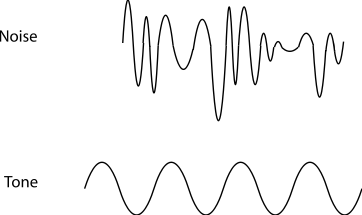
So how can you produce a tone? Let's say you have a sound wave trap (for now, don't worry about what it looks like), and you keep sending more sound waves into it. Picture a lot of pebbles being dropped into a very small pool. As the waves start reflecting off the edges of the pond, they interfere with the new waves, making a jumble of waves that partly cancel each other out and mostly just roils the pond - noise.
But what if you could arrange the waves so that reflecting waves, instead of cancelling out the new waves, would reinforce them? The high parts of the reflected waves would meet the high parts of the oncoming waves and make them even higher. The low parts of the reflected waves would meet the low parts of the oncoming waves and make them even lower. Instead of a roiled mess of waves cancelling each other out, you would have a pond of perfectly ordered waves, with high points and low points appearing regularly at the same spots again and again. To help you imagine this, here are animations of a and .
This sort of orderliness is actually hard to get from water waves, but relatively easy to get in sound waves, so that several completely different types of sound wave "containers" have been developed into musical instruments. The two most common - strings and hollow tubes - will be discussed below, but first let's finish discussing what makes a good standing wave container, and how this affects music theory.
In order to get the necessary constant reinforcement, the container has to be the perfect size (length) for a certain wavelength, so that waves bouncing back or being produced at each end reinforce each other, instead of interfering with each other and cancelling each other out. And it really helps to keep the container very narrow, so that you don't have to worry about waves bouncing off the sides and complicating things. So you have a bunch of regularly-spaced waves that are trapped, bouncing back and forth in a container that fits their wavelength perfectly. If you could watch these waves, it would not even look as if they are traveling back and forth. Instead, waves would seem to be appearing and disappearing regularly at exactly the same spots, so these trapped waves are called standing waves.
Note: Although standing waves are harder to get in water, the phenomenon does apparently happen very rarely in lakes, resulting in freak disasters. You can sometimes get the same effect by pushing a tub of water back and forth, but this is a messy experiment; you'll know you are getting a standing wave when the water suddenly starts sloshing much higher - right out of the tub!
For any narrow "container" of a particular length, there are plenty of possible standing waves that don't fit. But there are also many standing waves that do fit. The longest wave that fits it is called the fundamental. It is also called the first harmonic. The next longest wave that fits is the second harmonic, or the first overtone. The next longest wave is the third harmonic, or second overtone, and so on.
Figure 3.7. Standing Wave Harmonics
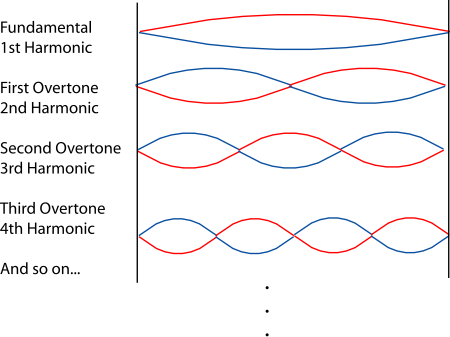
Notice that it doesn't matter what the length of the fundamental is; the waves in the second harmonic must be half the length of the first harmonic; that's the only way they'll both "fit". The waves of the third harmonic must be a third the length of the first harmonic, and so on. This has a direct effect on the frequency and pitch of harmonics, and so it affects the basics of music tremendously. To find out more about these subjects, please see Frequency, Wavelength, and Pitch, Harmonic Series, or Musical Intervals, Frequency, and Ratio.
You may have noticed an interesting thing in the animation of standing waves: there are spots where the "water" goes up and down a great deal, and other spots where the "water level" doesn't seem to move at all. All standing waves have places, called nodes, where there is no wave motion, and antinodes, where the wave is largest. It is the placement of the nodes that determines which wavelengths "fit" into a musical instrument "container".
Figure 3.8. Nodes and Antinodes

One "container" that works very well to produce standing waves is a thin, very taut string that is held tightly in place at both ends. (There were some nice animations of waves on strings available as of this writing at Musemath.) Since the string is taut, it vibrates quickly, producing sound waves, if you pluck it, or rub it with a bow. Since it is held tightly at both ends, that means there has to be a node at each end of the string. Instruments that produce sound using strings are called chordophones, or simply strings.
Figure 3.9. Standing Waves on a String
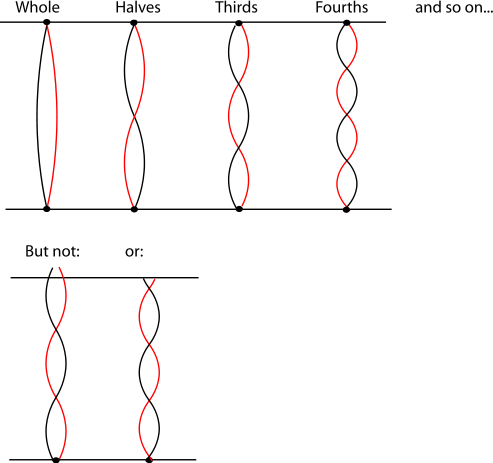
The fundamental wave is the one that gives a string its pitch. But the string is making all those other possible vibrations, too, all at the same time, so that the actual vibration of the string is pretty complex. The other vibrations (the ones that basically divide the string into halves, thirds and so on) produce a whole series of harmonics. We don't hear the harmonics as separate notes, but we do hear them. They are what gives the string its rich, musical, string-like sound - its timbre. (The sound of a single frequency alone is a much more mechanical, uninteresting, and unmusical sound.) To find out more about harmonics and how they affect a musical sound, see Harmonic Series.
Exercise 3.2.1. (Go to Solution)
When the string player puts a finger down tightly on the string,
-
How has the part of the string that vibrates changed?
-
How does this change the sound waves that the string makes?
-
How does this change the sound that is heard?
The string disturbs the air molecules around it as it vibrates, producing sound waves in the air. But another great container for standing waves actually holds standing waves of air inside a long, narrow tube. This type of instrument is called an aerophone, and the most well-known of this type of instrument are often called wind instruments because, although the instrument itself does vibrate a little, most of the sound is produced by standing waves in the column of air inside the instrument.
If it is possible, have a reed player and a brass player demonstrate to you the sounds that their mouthpieces make without the instrument. This will be a much "noisier" sound, with lots of extra frequencies in it that don't sound very musical. But, when you put the mouthpiece on an instrument shaped like a tube, only some of the sounds the mouthpiece makes are the right length for the tube. Because of feedback from the instrument, the only sound waves that the mouthpiece can produce now are the ones that are just the right length to become standing waves in the instrument, and the "noise" is refined into a musical tone.
Figure 3.10. Standing Waves in Wind Instruments

The standing waves in a wind instrument are a little different from a vibrating string. The wave on a string is a transverse wave, moving the string back and forth, rather than moving up and down along the string. But the wave inside a tube, since it is a sound wave already, is a longitudinal wave; the waves do not go from side to side in the tube. Instead, they form along the length of the tube.
Figure 3.11. Longitudinal Waves in Pipes
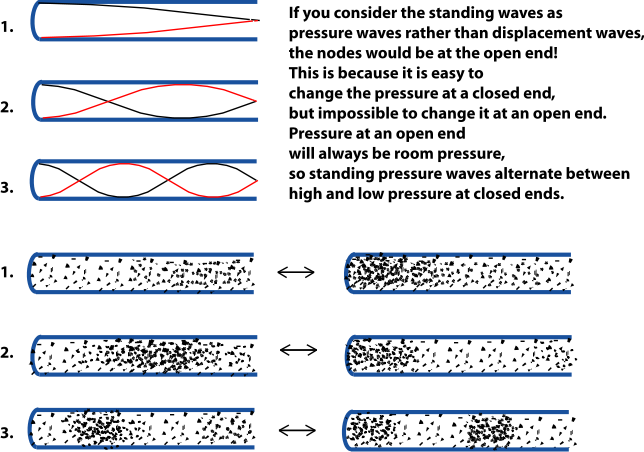
The harmonics of wind instruments are also a little more complicated, since there are two basic shapes (cylindrical and conical) that are useful for wind instruments, and they have different properties. The standing-wave tube of a wind instrument also may be open at both ends, or it may be closed at one end (for a mouthpiece, for example), and this also affects the instrument. Please see Standing Waves in Wind Instruments if you want more information on that subject. For the purposes of understanding music theory, however, the important thing about standing waves in winds is this: the harmonic series they produce is essentially the same as the harmonic series on a string. In other words, the second harmonic is still half the length of the fundamental, the third harmonic is one third the length, and so on. (Actually, for reasons explained in Standing Waves in Wind Instruments, some harmonics are "missing" in some wind instruments, but this mainly affects the timbre and some aspects of playing the instrument. It does not affect the basic relationships in the harmonic series.)
So far we have looked at two of the four main groups of musical instruments: chordophones and aerophones. That leaves membranophones and idiophones. Membranophones are instruments in which the sound is produced by making a membrane vibrate; drums are the most familiar example. Most drums do not produce tones; they produce rhythmic "noise" (bursts of irregular waves). Some drums do have pitch, due to complex-patterned standing waves on the membrane that are reinforced in the space inside the drum. This works a little bit like the waves in tubes, above, but the waves produced on membranes, though very interesting, are too complex to be discussed here.
Idiophones are instruments in which the body of the instrument itself, or a part of it, produces the original vibration. Some of these instruments (cymbals, for example) produce simple noise-like sounds when struck. But in some, the shape of the instrument - usually a tube, block, circle, or bell shape - allows the instrument to ring with a standing-wave vibration when you strike it. The standing waves in these carefully-shaped-and-sized idiophones - for example, the blocks on a xylophone - produce pitched tones, but again, the patterns of standing waves in these instruments are a little too complicated for this discussion. If a percussion instrument does produce pitched sounds, however, the reason, again, is that it is mainly producing harmonic-series overtones.
Although percussion specializes in "noise"-type sounds, even instruments like snare drums follow the basic physics rule of "bigger instrument makes longer wavelengths and lower sounds". If you can, listen to a percussion player or section that is using snare drums, cymbals, or other percussion of the same type but different sizes. Can you hear the difference that size makes, as opposed to differences in timbre produced by different types of drums?
Exercise 3.2.2. (Go to Solution)
Some idiophones, like gongs, ring at many different pitches when they are struck. Like most drums, they don't have a particular pitch, but make more of a "noise"-type sound. Other idiophones, though, like xylophones, are designed to ring at more particular frequencies. Can you think of some other percussion instruments that get particular pitches? (Some can get enough different pitches to play a tune.)
Solutions to Exercises
Solution to Exercise 3.2.1. (Return to Exercise)
-
The part of the string that can vibrate is shorter. The finger becomes the new "end" of the string.
-
The new sound wave is shorter, so its frequency is higher.
-
It sounds higher; it has a higher pitch.
Figure 3.12.
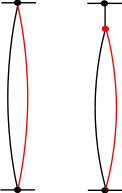
Solution to Exercise 3.2.2. (Return to Exercise)
There are many, but here are some of the most familiar:
-
Chimes
-
All xylophone-type instruments, such as marimba, vibraphone, and glockenspiel
-
Handbells and other tuned bells
-
Steel pan drums
3.1. Acoustics for Music Theory*
Music is sound that's organized by people on purpose, to dance to, to tell a story, to make other people feel a certain way, or just to sound pretty or be entertaining. Music is organized on many different levels. Sounds can be arranged into melodies, harmonies, rhythms, textures and phrases. Beats, measures, cadences, and form all help to keep the music organized and understandable. But the most basic way that music is organized is by arranging the actual sound waves themselves so that the sounds are interesting and pleasant and go well together.
A rhythmic, organized set of thuds and crashes is perfectly good music - think of your favorite drum solo - but many musical instruments are designed specifically to produce the regular, evenly spaced sound waves that we hear as particular pitches. Crashes, thuds, and bangs are loud, short jumbles of lots of different wavelengths. These are the kinds of sound we often call "noise", when they're random and disorganized, but as soon as they are organized in time (rhythm), they begin to sound like music. (When used as a scientific term, noise refers to continuous sounds that are random mixtures of different wavelengths, not shorter crashes and thuds.)
However, to get the melodic kind of sounds more often associated with music, the sound waves must themselves be organized and regular, not random mixtures. Most of the sounds we hear are brought to our ears through the air. A movement of an object causes a disturbance of the normal motion of the air molecules near the object. Those molecules in turn disturb other nearby molecules out of their normal patterns of random motion, so that the disturbance itself becomes a thing that moves through the air - a sound wave. If the movement of the object is a fast, regular vibration, then the sound waves are also very regular. We hear such regular sound waves as tones, sounds with a particular pitch. It is this kind of sound that we most often associate with music, and that many musical instruments are designed to make.
Figure 3.1.
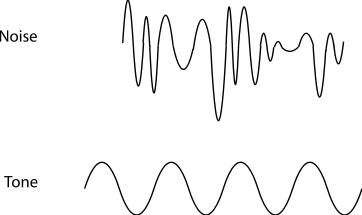
Musicians have terms that they use to describe tones. (Musicians also have other meanings for the word "tone", but this course will stick to the "a sound with pitch" meaning.) This kind of (regular, evenly spaced) wave is useful for things other than music, however, so scientists and engineers also have terms that describe pitched sound waves. As we talk about where music theory comes from, it will be very useful to know both the scientific and the musical terms and how they are related to each other.
For example, the closer together those evenly-spaced waves are, the higher the note sounds. Musicians talk about the pitch of the sound, or name specific notes, or talk about tuning. Scientists and engineers, on the other hand, talk about the frequency and the wavelength of the sound. They are all essentially talking about the same things, but talking about them in slightly different ways, and using the scientific ideas of wavelength and frequency can help clarify some of the main ideas underlying music theory.
So what are we talking about when we speak of sound waves? Waves are disturbances; they are changes in something - the surface of the ocean, the air, electromagnetic fields. Normally, these changes are travelling (except for standing waves); the disturbance is moving away from whatever created it, in a kind of domino effect.
Most kinds of waves are transverse waves. In a transverse wave, as the wave is moving in one direction, it is creating a disturbance in a different direction. The most familiar example of this is waves on the surface of water. As the wave travels in one direction - say south - it is creating an up-and-down (not north-and-south) motion on the water's surface. This kind of wave is fairly easy to draw; a line going from left-to-right has up-and-down wiggles. (See Figure 3.2.)
Figure 3.2. Transverse and Longitudinal Waves

But sound waves are not transverse. Sound waves are longitudinal waves. If sound waves are moving south, the disturbance that they are creating is giving the air molecules extra north-and-south (not east-and-west, or up-and-down) motion. If the disturbance is from a regular vibration, the result is that the molecules end up squeezed together into evenly-spaced waves. This is very difficult to show clearly in a diagram, so most diagrams, even diagrams of sound waves, show transverse waves.
Longitudinal waves may also be a little difficult to imagine, because there aren't any examples that we can see in everyday life (unless you like to play with toy slinkies). A mathematical description might be that in longitudinal waves, the waves (the disturbances) are along the same axis as the direction of motion of the wave; transverse waves are at right angles to the direction of motion of the wave. If this doesn't help, try imagining yourself as one of the particles that the wave is disturbing (a water drop on the surface of the ocean, or an air molecule). As it comes from behind you, a transverse waves lifts you up and then drops down; a longitudinal wave coming from behind pushes you forward and pulls you back. You can view here animations of:
The result of these "forward and backward" waves is that the "high point" of a sound wave is where the air molecules are bunched together, and the "low point" is where there are fewer air molecules. In a pitched sound, these areas of bunched molecules are very evenly spaced. In fact, they are so even, that there are some very useful things we can measure and say about them. In order to clearly show you what they are, most of the diagrams in this course will show sound waves as if they are transverse waves.
Both transverse and longitudinal waves cause a displacement of something: air molecules, for example, or the surface of the ocean. The amount of displacement at any particular spot changes as the wave passes. If there is no wave, or if the spot is in the same state it would be in if there was no wave, there is no displacement. Displacement is biggest (furthest from "normal") at the highest and lowest points of the wave. In a sound wave, then, there is no displacement wherever the air molecules are at a normal density. The most displacement occurs wherever the molecules are the most crowded or least crowded.
Figure 3.3. Displacement

The amplitude of the wave is a measure of the displacement: how big is the change from no displacement to the peak of a wave? Are the waves on the lake two inches high or two feet? Are the air molecules bunched very tightly together, with very empty spaces between the waves, or are they barely more organized than they would be in their normal course of bouncing off of each other? Scientists measure the amplitude of sound waves in decibels. Leaves rustling in the wind are about 10 decibels; a jet engine is about 120 decibels.
Musicians call the loudness of a note its dynamic level. Forte (pronounced "FOR-tay") is a loud dynamic level; piano is soft. Dynamic levels don't correspond to a measured decibel level. An orchestra playing "fortissimo" (which basically means "even louder than forte") is going to be quite a bit louder than a string quartet playing "fortissimo". (See Dynamics for more of the terms that musicians use to talk about loudness.) Dynamics are more of a performance issue than a music theory issue, so amplitude doesn't need much discussion here.
Figure 3.4. Amplitude is Loudness
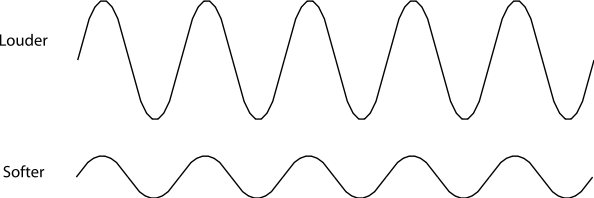
The aspect of evenly-spaced sound waves that really affects music theory is the spacing between the waves, the distance between, for example, one high point and the next high point. This is the wavelength, and it affects the pitch of the sound; the closer together the waves are, the higher the tone sounds.
All sound waves are travelling at about the same speed - the speed of sound. So waves with a shorter wavelength arrive (at your ear, for example) more often (frequently) than longer waves. This aspect of a sound - how often a peak of a wave goes by, is called frequency by scientists and engineers. They measure it in hertz, which is how many peaks go by per second. People can hear sounds that range from about 20 to about 17,000 hertz.
Figure 3.5. Wavelength, Frequency, and Pitch
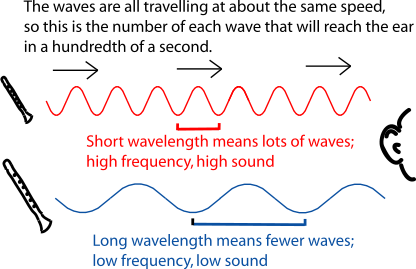
The word that musicians use for frequency is pitch. The shorter the wavelength, the higher the frequency, and the higher the pitch, of the sound. In other words, short waves sound high; long waves sound low. Instead of measuring frequencies, musicians name the pitches that they use most often. They might call a note "middle C" or "second line G" or "the F sharp in the bass clef". (See Octaves and Diatonic Music and Tuning Systems for more on naming specific frequencies.) These notes have frequencies (Have you heard of the "A 440" that is used as a tuning note?), but the actual frequency of a middle C can vary a little from one orchestra, piano, or performance, to another, so musicians usually find it more useful to talk about note names.
Most musicians cannot name the frequencies of any notes other than the tuning A (440 hertz). The human ear can easily distinguish two pitches that are only one hertz apart when it hears them both, but it is the very rare musician who can hear specifically that a note is 442 hertz rather than 440. So why should we bother talking about frequency, when musicians usually don't? As we will see, the physics of sound waves - and especially frequency - affects the most basic aspects of music, including pitch, tuning, consonance and dissonance, harmony, and timbre.
2.8. Classifying Music*
One of the first things needed when you begin the study of any subject is a little introduction to the "lingo." Since music is such a huge subject, some of the words used to talk about it are the terms that divide it up into smaller subjects, the way science is divided into biology, physics, and so on. So here are a few terms that may be useful if you are wondering what kind of music you want to learn more about.
Most of the music books you'll find on the shelf are about Western music. From the end of the Middle Ages to modern times, composers and performers in western Europe gradually developed widely accepted standards for tuning, melody, harmony, meter, notation, form, counterpoint and other music basics. These rules are a sort of grammar for the language of music. Just as the basic rules for putting together sentences and paragraphs help people understand each other, knowing what to expect from a piece of music helps people understand and like it.
Of course, music, like language, changes through the centuries. A Bach invention, a Brahms symphony, and a Beatles song are different forms in different genres, and at first they may sound as if they have nothing in common. But they all use the same musical "language" and follow basically the same rules. They are all examples of Western music, and are all more like each other than they are like a Navajo lullaby, a Chinese opera, or a west African praise song.
Wherever Europeans went during the colonial era, they took their music with them. So, in places like Australia and the Americas, not only do most of the people speak European languages, much of their music also sounds Western. What are the rules of this European musical language? A complete answer to that question would be long and complex, since Western music, like any living language shared by many different communities, has many "local dialects". The short answer is: Western music is generally tonal, based on major or minor scales, using an equal temperament tuning, in an easy-to-recognize meter, with straightforward rhythms, fairly strict rules on harmony and counterpoint, and not much improvisation. This is, of course, a huge generalization. Twentieth century art music, in particular, was very interested in breaking down or even rejecting these rules. But because they are flexible enough to allow plenty of interesting but easy-to-grasp music, the rules are still widely used, particularly in popular music. In fact, the use of these traditional rules for Western music is now so widespread that it is sometimes called common practice. They are what makes Western music sound familiar and easy to understand.
Non-Western music is any music that grew out of a different culture or musical tradition than the European. For someone who grew up listening to Western music, Non-Western music will have a recognizably exotic sound. This comes from the use of different tuning systems, different scales, different vocal styles and performance practices, and different approaches to melody and harmony.
You may find the terms "Western" and "Non-Western" to be too Eurocentric, but they are very well entrenched, so you'll need to know what they mean. If you want to avoid using the terms yourself, you can be more specific. You can speak, for example, of European classical or the European-American folk tradition, as opposed to Indian Classical, Japanese folk, or African-American musics.
Much of the music that is popular today cannot really be classified as completely Western or Non-Western. Since colonial times, when European cultures came into contact with many Non-Western cultures, musicians on all sides have been experimenting with music that is a blend of "the best of both worlds." Many musical styles have been invented that mix Western and Non-Western traditions. Perhaps the oldest and most widely popular of these styles are the ones that join European and African musical traditions. These include various Latin (from Central and South America, some of which also include Native American influences) and Caribbean traditions, and from North America, many different kinds of jazz and blues. Most American popular musics also grew out of this blending of traditions.
But the process of inventing new ways of fusing Western and Non-Western music continues today in countries all over the world. The term World Music is often used as a catch-all category referring to almost any music with widespread popularity that clearly does not sound like North American popular music. This includes older blended traditions such as rumba and samba, newer but well-established blended genres such as reggae and Afrobeat, and groups with unique experimental sounds borrowing from more than one tradition. Folk and traditional music from around the world is also sometimes included, but the most popular genres in this category tend to be those, such as Flamenco, Hungarian folk, and Celtic music, that are easy for Western-trained ears to understand. African-American traditions are so basic to popular music that they are generally not included in World music, but other North American traditions, such as Native American and Cajun traditions, sometimes are.
As mentioned above, Western music has not remained static through the centuries, either. It has changed and evolved as composers experimented with new sounds, ideas, and even new or evolving instruments.
Medieval European music, like many Non-Western traditions, was modal. This means that a piece of music was not in a particular key based on a major or minor scale. Instead, it was in a particular mode. A mode may look very much like a scale, since it lists the notes that are "allowed" in the piece of music and defines the tonic of the music. But a mode is usually also a collection of melodies, melodic phrases, or patterns that are found in that mode and not others (since the various modes are more different from each other than the various scales). Modes also may imply or suggest specific moods or they may be meant to have particular effects on the character of the listener.
Different keys may also evoke different moods, but the main purpose of a key is to define the chords and harmonic progressions that will be expected from a piece of music. From the Renaissance to the present day, most Western music has tended to be tonal. Tonal music is music in which the progression of the melody and harmony gives the strong feeling that the piece has a note and chord that are its "home base", so to speak (the tonic of the key). Think of a very familiar tune, perhaps "Row, Row, Row your Boat" or "Happy Birthday to You". Imagine how frustrating it would be to end that tune without singing the last note or playing the final chord. If you did this, most people would be so dissatisfied that they might supply that last note for you. That note is the tonal center of the tune, and without it, there is a feeling that the song has not reached its proper resting place. In tonal music, just about any melody is allowed, as long as it fits into the harmonies as they wander away from and then head back to their home base. Most Western tonal music is based on major and minor scales, both of which easily give that strongly tonal feeling. Some other scales, such as blues scales, also work well within a tonal framework, but others, such as whole-tone scales, do not.
Most of the Western music that is popular today is tonal, but around the beginning of the twentieth century, composers of "Classical" or Art music (see below) began experimenting with methods of composing atonal music. "Atonal" literally means "not tonal". As the name implies, atonal music treats all notes and harmonies as equal and in fact tries to avoid melodies and harmonies that will make the piece sound tonal. One type of atonal music is twelve-tone music, which seeks to use each of the notes of the chromatic scale equally. Other pieces may even dispense with the idea that music has to consist of notes; compositions may be collections of sounds and silences. Since the music is not organized by the familiar rules of Western music, many people have trouble appreciating atonal music without some help or study.
Music can be more or less tonal without becoming completely atonal, however. Music that does not stray at all from its key is called diatonic. Many Western children's songs, folk songs, and pop songs are in this category. But composers often add some notes or even whole sections of music that are from a different key, to make the music a little more complex and interesting. Music that goes even further, and freely uses all the notes of the chromatic scale, but still manages to have a tonal "home", is called chromatic. Music that has more than one tonal center at the same time (Ives was particularly fond of this composition technique) is called polytonal.
Popular music is, by definition, music that appeals to many people. You don't have to know anything about music to like a pop tune - it's "catchy". Art music is a catch-all term for any music that is enjoyed by a smaller crowd. This can include the more challenging types of jazz and rock music, as well as Classical. Most people agree that the appreciation of art music requires some study, careful listening, or other extra effort. But it can be harder to agree on what exactly belongs in this category. This is at least partly because popular tastes do change. For example, most operas were written to be popular, middle-class entertainments, and artists such as Liszt and Paganini enjoyed rock-star-like fame and popularity in their day. Today, however, nineteenth century operas are no longer considered popular entertainment, and popular works that could technically be considered opera - except for the fact that they are written in popular musical styles - are instead grouped with musicals. As another example, ragtime was wildly popular during Scott Joplin's lifetime. It later fell out of favor and was known only to some jazz connoisseurs. Then in the 1970's it became popular again.
Classical music is a confusing term with more than one meaning. In the visual arts, the term classical refers to ancient Greece and Rome. In the 1700's, Western Europeans became very interested in the ancient classical style, which was imitated by many artists, sculptors, and architects. Art historians call that period the neoclassical ("new classical"). Unfortunately, nobody really knows what the music of ancient times sounded like. So instead of being influenced by the sound of ancient Greek music, eighteenth-century composers were influenced by the ideals of classical art. The music of Mozart, Haydn, and the early works of Beethoven are in this style, which we call classical rather than neoclassical, because the original classical music of ancient Greece and Rome is lost. (And actually, it probably would sound very exotic and Non-Western to us if we could listen to it!)
So the original classical music comes from one fairly short era. The other great composers of Western music lived during other periods: Bach and Handel were Baroque era composers, for example; Brahms and Wagner, Romantic; and Ravel and Debussy, Impressionist. But most people do not know which music is from which period. So all of the music of the great Western composers of the past (as well as modern art music that is part of the same tradition) is lumped together and called classical. The art music of other cultures is also often called classical; for example, people speak of the classical music of India.
The terms "folk music" and "pop music" also have more than one meaning. The folk music of a culture is the music that is passed down from one generation to the next, often without writing it down. It includes many different kinds of music: lullabies and children's singing games, tunes that everyone enjoys singing together or dancing to, songs for celebrations, ceremonies, and holidays. Folk music can gradually change as it gets passed along. Usually nobody remembers who originally wrote it, or who changed it, and there may be more than one version of any particular folk song. Since ancient times, folk music has been the music of ordinary people, not the ruling class or professional musicians. In every culture, children learned and remembered the music that everyone enjoyed the most, and the music that was important to their traditions.
The modern recording industry has changed things, though. In many cultures, pop music has largely replaced folk music as the music that everyone knows. Unlike folk music, it has usually been written recently and belongs to professional musicians, and new popular tunes quickly replace old ones. Even the types of music that are considered popular can change quickly. The term pop music can refer to a specific kind of popular music, as in "bubblegum pop". Popular music is also a general term for any type of music that is or has been a top seller. This includes most types of rock music and some kinds of jazz.
As the rise of recording pushed aside traditional music, some musicians made a point of recording traditional folk songs, so they would not be lost altogether. Some also wrote new songs in a "folk" style that enjoyed some popularity, particularly in the 1960's. Although these modern tunes do not fit the traditional definition, they are also called folk music.
It can be difficult to follow a discussion of music without hearing some examples. If you would like to hear some music in the categories above, or you are planning to present this lesson to a class, here are some easy-to-find suggestions. Some categories also include suggestions for where to start if you want more information.
Tonal, Atonal, and Modal Music
-
To hear tonal music, turn on the radio and listen to just about any station, unless your Classical station is playing twentieth century music.
-
In the modal music category, medieval chant and the classical music of India are easiest to find.
-
Even in the category of twentieth century music, the shelves tend to be stocked with the work of composers who stayed with some sort of tonality (Ralph Vaughan Williams, George Gershwin, and Aaron Copland, for example). For atonality look for John Cage, Arnold Schoenberg, Anton Webern, or Edgard Varese.
Western Classical
-
From the actual classical period: listen to anything by Mozart or Haydn, or Beethoven's early works.
-
From other periods: listen to Bach or Vivaldi (Baroque), Brahms, Schubert, Chopin, or Tchaikovsky, or Beethoven's later works (Romantic), Ravel or Debussy (Impressionist), Stravinsky, Hindemith, or Schoenberg (Modern).
-
A History of Western Music by Donald Jay Grout is a scholarly source of information.
-
The Music Makers, edited by Clive Unger-Hamilton, is an easy-to-read combination of history and reference book.
-
Most standard music dictionaries and encyclopedias also focus almost exclusively on Western Classical music.
-
For children, there are many appropriate picture books and even videos on the lives and music of the most famous composers. Also, look for picture books that summarize the plot of a famous opera or ballet.
-
Any standard music theory book or course will introduce the basics of Western music.
Non-Western Classical
-
The only easy-to-find items in this category are Indian Classical music, for example the performances of Ravi Shankar.
-
A web search for classical music from a particular country may turn up some sound clips. At the time of this writing, for example, sound clips could be found of Chinese Opera and Tunisian classical music.
Western Folk
-
For the sound of traditional Western folk music, look for collections of folk music from England or Australia, sea shanties, or American cowboy songs. For young students, Wee Sing's "Fun 'n' Folk" and "Sing-Alongs" book-and-tape sets are good sources.
-
To hear modern folk-style music, listen to Joan Baez, John Denver, Bob Dylan's protest music, Simon and Garfunkel, or Peter, Paul and Mary.
-
The Rough Guide series of books and recordings includes some that examine modern folk artists. This would be a good place to start learning more on the subject of modern folk music.
Non-Western Folk
-
If you live in a Western culture, it can be difficult to find recordings of non-Western folk music, since most Western listeners do not have a taste for it. For children, Wee Sing publishes an "Around the World" book and tape with children's songs from all over.
-
The Music for Little People catalogue also has some recordings that introduce children to music from other cultures.
-
For adults, Ellipsis Arts publishes traditional music from non-Western cultures. Check your local library's recording section for music from Africa or Asia, or for the music of native Americans or Australians.
-
Some of the Rough Guide series focus on specific folk or traditional musics.
Music that Combines Western and Non-Western Traditions
-
For music that has been combining elements of both for long enough to have developed its own traditions, listen to any jazz, blues, gospel, Latin dance, or reggae. There are many books on these musics, particularly on jazz and reggae. For a comprehensive audiovisual overview of jazz, try Ken Burns' PBS documentary.
-
Almost all popular music is heavily influenced by both African and European traditions. Turn on the radio.
-
To hear what is going on in modern Non-Western cultures as their musicians are influenced by American and European pop, listen to "World" music. The Rough Guide series is a good place to start learning about this subject.
2.7. Range*
The range of a voice or instrument is the set of pitches, from lowest to highest, that it can sing or play. A range can be described using the appropriate octave identification, for example, "from one-line c to two-line g". But it is often easiest to write the range on a staff, as the two notes at the high and low ends of the range.
A piece of music, or one performer's part in that piece, may also be described as having a range, from the lowest to highest note written for the performer in that piece. There is usually a difference (sometimes a large one) between the total range of the part and a smaller range that the part stays in most of the time (heading to the extreme highs and lows only occasionally). This smaller range is called the tessitura of the part. One can also speak of the tessitura of a performer's voice, which is the range in which it sounds the best (so that matching the tessitura of the part and of the performer is a very good idea). Notice the similarity between this second definition and the term power range, sometimes used to describe the most powerful or useful part of an instrument's range.
A register is a distinctive part of a vocal or instrumental range. For example, singers may speak of the head register, in the upper part of their range, and the chest register in the lower part of their range. These two registers sound and feel very different, and the singer may have even have two distinct tessituras, one in each register. The large range of the clarinet is also divided into distinctive registers with different capabilities and very different timbres. Even when an instrument does not have a very large variation in timbre over its range, its players may speak of the difficulty of "playing in the high register" or a "dull timbre in the low register".
Figure 2.8. Describing a Range

A typical choral arrangement divides women into higher and lower voices and men into higher or lower voices. Most voices can be assigned one of these four ranges, and this gives the composer four vocal lines to work with, which is usually enough. The four main vocal ranges are:
-
Soprano – A high female (or boy’s) voice
-
Alto – A low female (or boy’s) voice
-
Tenor – A high (adult) male voice
-
Bass – A low (adult) male voice
Arrangements for these four voices are labelled SATB (for Soprano Alto Tenor Bass). The ranges of the four voices overlap, but singers may find themselves straining or getting an unpleasant sound at the top or a weak sound at the bottom of their ranges. So although the full ranges of an alto and a soprano may look quite similar, the soprano gets a strong, clear sound on the higher notes, and the alto a strong, clear sound in the lower part of the range. But there are vocalists whose strong, best-sounding range falls in a distinctly different place from any of these four voices. The names for some of these ranges are:
-
Coloratura Soprano – This is not really a different range from the soprano, but a coloratura soprano has a voice that is unusually high, light, and agile, even for a soprano.
-
Mezzo-soprano – In between soprano and alto
-
Contralto – Contralto and alto originally referred to the same voice. But some people today use “contralto” to refer to a female voice that is even lower than a typical alto
-
Countertenor – A male voice that is unusually high, light, and agile, even for a tenor
-
Baritone – A male voice that falls in between tenor and bass
Figure 2.9. Vocal Ranges
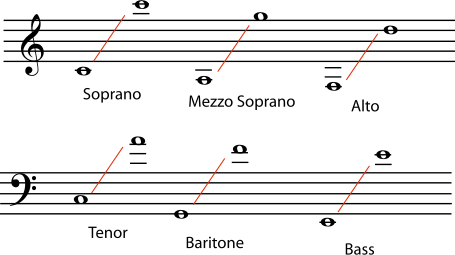
The same terms used to identify vocal ranges are also often used to identify particular instruments. For example a bass trombone has a lower range than a tenor trombone, and an alto saxophone sounds higher than a tenor saxophone. Some other terms that are used to describe instrument ranges are:
-
Contra – Means lower: for example a contrabassoon sounds lower than a regular bassoon, and a contrabass clarinet is even lower than a bass clarinet.
-
Piccolo- Means higher (literally "smaller"): for example, a piccolo trumpet is higher than a regular trumpet.
-
A Note Name – If an instrument comes in several different sizes (and ranges), the name of a particular size of the instrument may be a note name: for example, an F horn, a B flat clarinet, and a C trumpet. The note name is the name of the fundamental harmonic of the instrument. An instrument with a slightly higher fundamental will have a slightly higher range; an instrument with a much lower fundamental will have a much lower range. Some instruments that are identified this way are transposing instruments, but others are not.
The ranges of some instruments are definite and absolute. For example, even a beginning piano player can play the highest and lowest keys; and even the best player cannot play beyond these. But the ranges of many instruments are, like vocal ranges, not so definite. For example, an experienced horn or clarinet player can play much higher and lower notes than a beginner. An exceptional trumpet player may be able to play - with good sound and technique – high notes that the average high school trumpet player cannot play at all.
Other instruments may be a mix of absolute and indefinite ranges. For example, on any string instrument, nobody can play lower than the note that the lowest string is tuned to. But experienced players can easily play very high notes that inexperienced players have trouble playing well.
So it is sometimes useful to distinguish between a possible range, which includes the notes that a very experienced player can get, and a practical range, that includes all the notes that any competent player (including a good younger player) can get.
Outside of the instrument’s practical range, it may be a strain for even a very good player to play long or tricky passages. So if you are composing or arranging, it’s a very good idea to be able to distinguish between these two ranges for the voices or instruments you include.
Some sources even list the power range of an instrument or voice. This is the part of the range where the instrument or voice is particularly strong. It may be in the middle of the range, or at the top or bottom, but writing in the power range should guarantee that the part is easy to play (or sing), sounds clear and strong, and can be easily heard, even when many other instruments are playing.





